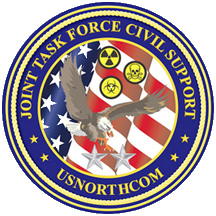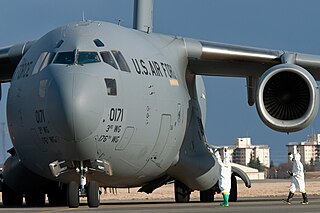Biodefense refers to measures to restore biosecurity to a group of organisms who are, or may be, subject to biological threats or infectious diseases. Biodefense is frequently discussed in the context of biowar or bioterrorism, and is generally considered a military or emergency response term.

Chemical, biological, radiological and nuclear defense or NBC protection is protective measures taken in situations in which chemical, biological, radiological or nuclear hazards may be present. CBRN defense consists of CBRN passive protection, contamination avoidance, and weapons of mass destruction mitigation.

The Special Operations Engineer Regiment (SOER) is a specialised unit of the Australian Army. The regiment forms part of the Special Operations Command. The unit was formed in 2002 as the Incident Response Regiment (IRR), they are deployed to respond to chemical, biological, radiological, nuclear or explosive incidents. The regiment was transferred into the newly raised Special Operations Command in 2003. In 2010 and 2011, its role changed to supporting the army's special forces units, and it was renamed accordingly.

Canadian Special Operations Forces Command is a command of the Canadian Armed Forces. It is responsible for all special forces operations that respond to terrorism and threats to Canadians and Canadian interests around the world.
In the United States Army, the term combat support refers to units that provide fire support and operational assistance to combat elements. Combat support units provide specialized support functions to combat units in the following areas

The Canadian Joint Incident Response Unit (CJIRU) of the Canadian Armed Forces was created "to provide timely and agile broad-based CBRN support to the Government of Canada in order to prevent, control and mitigate CBRN threats to Canada, Canadians, and Canadian interests". It is a sub-unit of the Canadian Special Operations Forces Command (CANSOFCOM).

The Defence Chemical, Biological, Radiological and Nuclear Centre is a United Kingdom military facility at Winterbourne Gunner in Wiltshire, south of Porton Down and about 4 miles (6 km) north-east of Salisbury. It is a tri-service location, with the Army being the lead service. The centre is responsible for all training issues relating to chemical, biological, radiological and nuclear (CBRN) defence and warfare for the UK's armed forces.

The 20th CBRNE Command is the United States Army headquarters for defense against Chemical, Biological, Radiological, and Nuclear weapons and high-yield explosives (CBRNE), headquartered on the site of the defunct Edgewood Arsenal chemical weapons production facility at Aberdeen Proving Ground in northern Maryland.

Joint Task Force Civil Support (JTF-CS) is a subordinate command of United States Northern Command headquartered at Fort Eustis. Its mission is to provide command and control for Department of Defense forces deployed in support of the National Response Plan, specifically, managing the consequences of a domestic chemical, biological, radiological, nuclear, or high-yield explosive (CBRNE) incident. JTFCS consists of discrete units of specialized consequence management troops from all services called the DOD CBRN Response Forces (DCRF), as well as civilian subject matter experts, assigned from various agencies. JTF-CS is able to respond anywhere in North America within 12 hours to lead technical and non-technical search and rescue, security, hazard analysis, evidence collection, mission command, logistics support, aviation support, and medical support after an actual or threatened CBRNE incident. JTF-CS is also a collaborative partner in planning for and responding to identified National Special Security Events (NSSE) around the United States.
The 464th Chemical Brigade was a chemical unit in the United States Army Reserve from February 1972 until September 2008.
The United States Marine Corps is tasked by Department of Defense directive to "conduct complex expeditionary operations in the urban littorals and other challenging environments" and "conduct amphibious operations, including engagement, crisis response, and power projection operations to assure access." Before 2006, the Marine Corps was the only branch of the Armed Forces that did not have any of its special warfare elements participating in the United States Special Operations Command (USSOCOM), due to confining its special operations capabilities only for the purpose to the Fleet Marine Force.

The United States Army CBRN School (USACBRNS), located at Fort Leonard Wood, Missouri, is a primary American training school specializing in military Chemical, Biological, Radiological, and Nuclear (CBRN) defense. until 2008, it was known as the United States Army Chemical School.

National Response Scenario Number One is the United States federal government's planned response to a small scale nuclear attack. It is one of the National Response Scenarios developed by the United States Department of Homeland Security, considered the most likely of fifteen emergency scenarios to impact the United States. The Scenarios are related to the National Response Framework (NRF), which describes the structures and mechanisms of a response and the National Incident Management System (NIMS) that gives a framework to orchestrate emergency management. The scenario anticipates terrorists detonating a single, 10 kiloton weapon in a major city, as opposed to a full-scale nuclear war, in which a foreign power such as Russia or China would detonate hundreds or thousands of weapons.

The G7-led Global Partnership Against the Spread of Weapons and Materials of Mass Destruction is an international security initiative announced at the 2002 G8 summit in Kananaskis, Canada, in response to the September 11 attacks. It is the primary multilateral group that coordinates funding and in-kind support to help vulnerable countries around the world combat the spread of weapons and materials of mass destruction (WMDs).

The Emergency Management (EM) career field is the United States Air Force's (USAF) primary organization responsible for implementing an installation-level EM program. Emergency Managers, also known by the Air Force Specialty Code (AFSC) 3E9X1, are the Air Force's subject matter experts for all non-medical Chemical, Biological, Radiological and Nuclear (CBRN) passive defense and consequence management matters.
During wartime operations, 3E9X1s are assigned to CBRN reconnaissance teams responsible for detecting, identifying, quantifying, and collecting CBRN material ensuring mission continuation and force survivability.
The 415th Chemical Brigade is a chemical unit in the United States Army Reserve, located in Greenville, South Carolina.

CBRNE Enhanced Response Force Packages (CERFP) are an initiative of the United States National Guard designed to integrate existing national guard units into the broader federal and local civilian emergency response personnel in instances of chemical, biological, radiological, nuclear and explosive (CBRNE) disasters. The creation of CERFPs by the US Congress in 2004, initially provided for the creation of 12 teams corresponding to the 10 region designations of the Federal Emergency Management Agency, and two teams for regions three and nine, on the US east and west coasts respectively. This was later expanded in 2006 for a total of 17 teams nationwide.
14 CBRN Regiment, Sri Lanka Engineers is a regiment of the Sri Lanka Army that focuses on countering chemical, biological, radiological and nuclear (CBRN) hazards in the country. The Sri Lanka Navy and Sri Lanka Air Force also maintain CBRN units in addition to the Army's CBRN regiment. The regiment evolved from the first CBRN squadron that Major General Jagath Gunawardena, the current colonel-commandant of Sri Lanka Engineers, established.
No. 49 Chemical Biological Radiological Nuclear and Explosive Wing was established in 2016 at the SLAF Bandaranayake. The unit's first Commanding Officer was Squadron Leader Nilendra Perera, who continues to hold this office. The wing is equipped with modern equipment required to counter chemical, biological, radiological, nuclear and high yield explosive threats.















